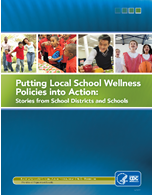Local School Wellness Policy
A local school wellness policy (wellness policy) is a written document that guides a local educational agency or school district’s efforts to create supportive school nutrition and physical activity environments. Each local education agency participating in federal Child Nutrition Programs, including the National School Lunch Program or the School Breakfast Program, is required to develop and implement a wellness policy as established by the Child Nutrition and WIC Reauthorization Act of 2004, and recently enhanced by the Healthy, Hunger-Free Kids Act of 2010 (HHFKA)[PDF - 325.4 KB]. Wellness policies can be integrated into the Whole School, Whole Community, Whole Child (WSCC) model for school health, and can help put into action several provisions of the Every Student Succeeds Act, including Title I and Title IV.
Local School Wellness Policy Requirements
School districts can develop wellness policies to meet the unique needs of each school under its jurisdiction, but at a minimum are required to
- Include goals for nutrition promotion and education, physical activity, and other school-based activities that promote students wellness. In developing these goals, local educational agencies must review and consider evidence-based strategies.
- Include nutrition guidelines for all foods sold on each school campus during the school day that are consistent with federal regulations for school meals and Smart Snacks in School nutrition standards.
- Include policies for foods and beverages made available to students (e.g., in classroom parties, classroom snacks brought by parents, other foods given as incentives).
- Include policies for food and beverage marketing that allow marketing and advertising of only those foods and beverages that meet the Smart Snacks in School nutrition standards.
- Permit parents, students, representatives of the school food authority, teachers of physical education, school health professionals, the school board, school administrators, and the general public to participate in the development, implementation, and update of the local school wellness policy.
- Identify one or more school districts or school officials who have the authority and responsibility to ensure each school complies with the policy.
- Inform and update the public (including parents, students, and others in the community) about the local school wellness policy on an annual basis.
- At least once every three years, measure the extent to which schools are in compliance with the local school wellness policy, the extent to which the local education agency’s local wellness policy compares to model local school wellness policies, and the progress made in attaining the goals of the local wellness policy, and make this assessment available to the public.
- Comply with all of these requirements by June 30, 2017.
Putting Local School Wellness Policies into Action
 Putting Local School Wellness Policies into Action: Stories from School Districts and Schools [PDF - 890 KB] is a compilation of 11 stories that provide examples of steps and strategies used to implement wellness policies, including activities in key areas such as improving school meals and increasing physical activity levels among students.
Putting Local School Wellness Policies into Action: Stories from School Districts and Schools [PDF - 890 KB] is a compilation of 11 stories that provide examples of steps and strategies used to implement wellness policies, including activities in key areas such as improving school meals and increasing physical activity levels among students.
- Local Wellness Policy Briefs and Resources: 2012–2013 School Year
- Local Wellness Policy Briefs and Resources: 2011–2012 School Year
 Local School Wellness Policies: Where Do They Stand and What Can You Do? [PDF - 736 KB]
Local School Wellness Policies: Where Do They Stand and What Can You Do? [PDF - 736 KB]- Supporting Quality Physical Education and Physical Activity in Schools [PDF - 900 KB]
- Supporting Recess in Elementary Schools [PDF - 391 KB]
- Creating Supportive School Nutrition Environments [PDF - 661 KB]
- Improving Access to Drinking Water in Schools [PDF - 284 KB]
- Marketing and Promotion of Foods and Beverages at School [PDF -280 KB]
- Addressing Weight Status Measurement in Schools [PDF - 405 KB]
- Methods Document for the CDC and Bridging the Gap Local School Wellness Policy Briefs [PDF - 161 KB]
- School District Wellness Policies: Where do they Stand and What do you Need to Know? PowerPoint® Presentation [PDF - 2.8 MB] [PPT - 7.3 MB]
- Local School Wellness Policies: Where Do They Stand and What Can You Do? [PDF - 742 KB]
- Supporting Quality Physical Education and Physical Activity in Schools [PDF - 934 KB]
- Supporting Recess in Elementary Schools [PDF - 388 KB]
- Creating Supportive School Nutrition Environments [PDF - 688 KB]
- Improving Access to Drinking Water in Schools [PDF - 292 KB]
- Marketing and Promotion of Foods and Beverages at School [PDF -370 KB]
- Addressing Weight Status Measurement in Schools [PDF - 415 KB]
- Methods Document for the CDC and Bridging the Gap Local School Wellness Policy Briefs [PDF - 159 KB]
- School District Wellness Policies: Where do they Stand and What do you Need to Know? PowerPoint® Presentation [PDF - 2.2 MB] [PPT - 3.6 MB]
Additional Resources
- USDA Local School Wellness Policy Overview
Overview of required local wellness policy requirements. - USDA Local Wellness Policy Resources
Resources to help local education agencies meet wellness policy requirements. - USDA Local School Wellness Policy Outreach Toolkit
Resources to increase awareness of local school wellness policies and provide strategies for school staff and parents to get involved. - CDC School Health Index
Online self-assessment and planning tool. - CDC School Nutrition Environment
Defines the school nutrition environment and describes how it affects students’ access to healthy foods and beverages at school. - CDC’s School Health Guidelines to Promote Healthy Eating and Physical Activity
Evidence-based strategies and best practices to inform the development, implementation, and evaluation of school-based healthy eating and physical activity policies and practices. - WellSAT: Wellness School Assessment Tool
Tool to assess the comprehensiveness and strength of school wellness policies. - Team Nutrition Healthier Middle Schools: Everyone Can Help
Tools to engage teachers, principals, parents, food service managers and students in school wellness efforts. - Wellness Policy Tool: Seven Steps to Success
Tool to identify policy options and develop local wellness policies. - Alliance for a Healthier Generation Wellness Policy Resources
Resources for schools and school districts to create sustainable healthy school environments. - Guide for Physical Education Policy [PDF-402KB]
Tool to develop and evaluate physical education policies at the state, school district, or school level. - Guide for Recess Policy [PDF-2.2MB]
Tool to develop and evaluate recess policies at the state, school district, or school level. - Bridging the Gap (BTG) Research on District Wellness Policies
Research products related to BTG’s annual collection and coding of school district wellness policies. - Nutrition and Obesity Policy Research and Evaluation Network (NOPREN) School Wellness Working Group
Working group or researchers and practitioners who focus on policies and strategies to improve school wellness.
- Page last reviewed: January 17, 2017
- Page last updated: January 17, 2017
- Content source:



 ShareCompartir
ShareCompartir